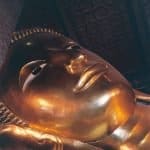World War II history lessons
Today I want to visit the last places in my travel schedule here in Kanchanaburi. I rent a bicycle near the guesthouse. The program includes the Wat Khao Pun cave and the JEATH War Museum. The Japanese used Wat Khao Pun during World War II as storage space for ammunition and such but now filled with Buddha and Hindu statues. The cave is about 10 kilometers away on the other side of the river, also the furthest point of my trip today.

Challenging bicycle ride to the cave
With a map supplied by my guesthouse – though not to scale – I find the cave reasonably easy. To reach the site, you have to drive up a hill at the end — quite a challenge with my rickety bike. I arrive almost completely exhausted. I decide to rest a bit and have a soda before going down into the cave.
Buddha and Hindu relics inside a former storage cave

Inside Wat Khao Pun regularly you have to crawl through narrow dens to get further; it is all somewhat creepy – especially as I also walk around the place alone. In the larger rooms, and even in all sorts of corners and niches, you will find many statues Of Buddha`s and Hindu gods. Bats are also present. I am satisfied that I have made an effort to visit this cave.

Kanchanaburi has 2 war cemeteries
About a mile away on the way back is a war cemetery, which I also visit. In the center of Kanchanaburi, there is another one, but I skip that one. After a rest at the edge of the river for a while, I head to my last destination for today, the JEATH war museum. JEATH stands for Jew, English, American, Australian, Thai, and Holland, but also as a pun on death. The museum was founded by a Buddhist monk to explain the atrocities committed by the Japanese during World War II.
Searching for the entrance of the war museum

It takes some effort to find the museum. I know it is beyond the pier where the floating discos sail off at the weekend. But the place is hardly indicated. At some point, I arrive, but I can not find the entrance anywhere. There are several temples here, but the museum itself is housed in a bamboo shack, a replica of the barn in which the prisoners of war once housed. A Thai sees me searching and shows me the entrance.

The JEATH war museum shows the cruelties of the Japanese in World War II
The visit to the war museum turns into a very educational experience. Photos, newspaper articles, and other materials reveal the prisoners’ terrible living conditions; only 70 centimeters width of sleeping space per person, meals that only consisted of rice and salt. These people have had to endure enormous hardships. The Japanese hardly show themselves at the JEATH barn out of shame, even though this museum aims to stimulate peaceful coexistence between peoples. The museum, also though it is not large, leaves a deep impression on me.
Many casualties while building the Burma-railway

Incidentally, all of this history revolves around the construction of a 400-kilometer railway line to make Burma (now: Myanmar) accessible and available so that the Japanese could start an offensive against India from there. Nowadays, on the border with Myanmar, you can also visit the famous Hell’s Pass, a gorge carved into the rocks with bare hands and simple materials, where 400 people died during the work.
Nearly 200,000 people died because of the Burma-railway
In 1985, this entire Burma-railway route was completely overgrown by the jungle. Understandably, a whole tourist attraction has been created around this place. But it would be nice if every visitor would also know that 170,000 people were killed in this area during the construction of the train track. Affected but more knowledgeable, I leave the JEATH war museum and return to my guesthouse.
Hoping to return someday

After returning the bike, I go to my room for a rest. And after a shower and a shave, I go out for dinner. Making contact with the other tourists here is not so easy, so I retire to my porch. The next morning after breakfast, I say goodbye to the owner of the guesthouse and his staff. I hope to return someday.
Return to Bangkok by bus
50 meters further down the road, he told me, I can take a taxi or songthaew to the bus station, but there is none available. I have to leave on the back of a motorcycle, with all my luggage a somewhat risky business. But all in all, the ride is not too bad. At the bus station. I buy a ticket for the 2nd class bus to Bangkok, and I am lucky. There is one ready for departure.
Driver fixing a broken drive belt
The driver – a small, blocked man – is of the active type; he uses the horn at the least, and when he speaks to his assistant, his volume cannot be high enough. After an hour – almost halfway – he parks the bus and starts rolling up his sleeves. I quickly see why; he is replacing a drive belt. Ten minutes later, we drive again. With filthy hands, he jerks on to the wheel and the gear lever. The traffic is getting busier and busier; it is clear that we are approaching Bangkok again.







